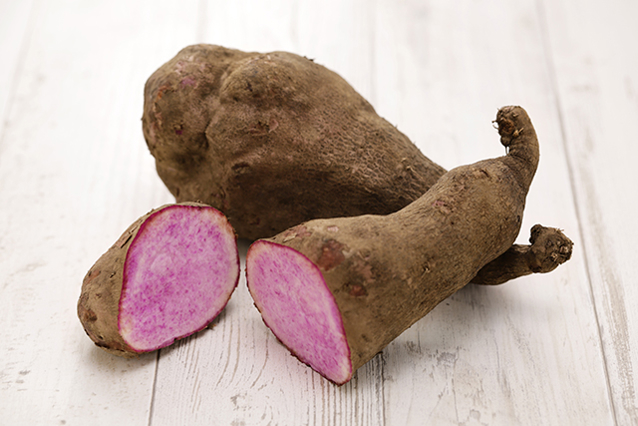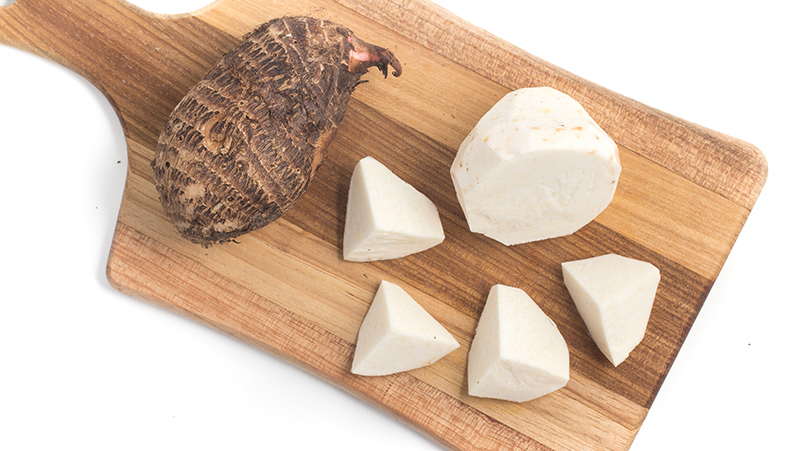Yates Account
Join now
Create a Yates account today!
Sign up to join the Yates Garden Club for monthly e-mails packed with seasonal inspiration, tips for success & exclusive promotions.
Plus if you’re a Garden Club member you can take part in the Yates Growing Community - a blog to share successes, get advice & win prizes in fun challenges along the way!

Forgot password
Enter the email address associated with your account, and we'll email you a new password.

Purple Yams (AKA Ube) are one of the easiest and most productive plant tubers to cultivate. Once established, it can keep cropping and if a tuber's left in the ground it will sprout up over time.
Purple Yams have a sweetly subtle flavour and can be roasted, mashed or steamed. They also make amazing desserts, lending a vibrant purple hue to sweet treats like ube halaya.
Purple yam has a sweet, slightly earthy flavour and can cooked in the same way as kūmara. While some cultivars have white or pink-tinged tubers, the more usual vivid purple colour is due to their high anthocyanin content.
How to grow purple yam in a garden
- You can buy purple yams from a fruit & veg retailer, cut them into a few chunks, pop them into a bucket of moist sandy soil and then wait for them to start sprouting. When they sprout, they’re ready to plant out (when all danger of frost has passed, from late October).
- Enrich well drained soil by digging in compost & Yates Thrive Natural Blood & Bone with Seaweed. If the soil is clay based, add gypsum and fork in well.
- Prepare furrows, space between rows about 50 cm and plant the sprouted yams in to the soil at a depth of 15 cm. Place the new growth upwards.
- Water in well.
- Light mulching with organic mulch like bark chips, pea or lucerne straw will ensure moisture retention in the soil.
- Water at least two times a week, depending on weather conditions.
- Feed every 6-8 weeks from spring to mid autumn with Yates Thrive Natural Blood & Bone with Seaweed. During flowering and fruiting stages feed weekly with Yates Thrive Natural Fish Seaweed+ Plant Food Concentrate.
- Tubers will push through soil so mounding them with soil is required. In frost prone regions, it can be harvested after the first frost as the cold improves flavour and sweetness. Pull out the Yams by digging into the soil. Wash them thoroughly and can be used for cooking immediately (please be cautious and don't eat raw purple yam - it contains a toxic compound called dioscorine, which needs to be neutralised by proper cooking).
- You can store yam tubers in a cool dark place for a few months.

How to grow purple yam in a pot
- Choose a pot at least 600 mm wide or large rectangular pots. Fill with quality potting mix, such as Yates Premium Potting Mix.
- Add a small amount of Yates Waterwise Water Storage Crystals to the mix. These will help hold extra moisture.
- Plant the sprouted tubers about 10 cm deep and backfill with potting mix.
- Position the pots in full sun. Water in well.
- Add light mulch over the potting mix surface with organic mulch like bark, chips, woodchip or pea straw.
- Once planted, keep the pot adequately watered, but don’t let the water sit in a saucer at the base of the pot.
- Feed every 6-8 weeks from spring to mid autumn with Yates Thrive Natural Blood & Bone with Seaweed. During flowering and fruiting stages feed weekly with Yates Thrive Natural Fish Seaweed+ Plant Food Concentrate.
- Tubers will push through soil so mounding them with soil is required. In frost prone regions, it can be harvested after the first frost as the cold improves flavour and sweetness. Pull out the Yams by digging into the soil. Wash them thoroughly and can be used for cooking immediately. Or you can store them in a cool dark place for a few months.
Growing tips
- This plant is pretty invasive, so if you want to use the garden bed for other vegetables in the future it's best to plant them in containers or dedicate a separate space for cultivating them.
- In the United States, kūmara or sweet potato (Ipomoea batatas) is known as 'yam'. New Zealand yams (Oxalis tuberosa), on the other hand, are known as 'Oca' everywhere else in the world.
- CAUTION: Don't eat raw purple yam - it contains a toxic compound called dioscorine, which needs to be neutralised by cooking.
- Purple yams require very little attention and management.
- They grow rapidly in the warmer months.
They may make you cry, but onions are worth the tears! They can impart such a sweet or savoury flavour to your dishes, depending on how they’re used.
Shallots
Shallots can be grown from seed or 'sets' (small dried bulbs). They're a versatile ingredient that adds real depth and complexity to your dishes. The subtle flavour profile is great for soup, stews, salad, stir fries and sauces.
Lettuce
The perfect salad leaf or sandwich filler! Here's how to easily grow lettuce in your garden or in pots.
Melons
Watermelons, rockmelons and honeydew – the quintessential summer fruit trio! They’re oh-so-sweet, juicy and delicious when eaten straight from the fridge
Recommended products
Yates Thrive Natural Blood & Bone with Seaweed
A certified organic garden input boosted with NZ Seaweed to gently nourish plants, enrich the soil and encourage a strong healthy root system.
Yates Thrive Natural Fish & Seaweed+ Plant Food Concentrate
A complete plant food enriched with natural fish, seaweed, humates, molasses and more - boosted with NPK to improve plant and soil vitality.
Yates Premium Potting Mix
A premium potting mix, ideal for all potted plants and shrubs, including ornamentals, fruit trees, vegies and herbs.
Yates Waterwise Water Storage Crystals
Ideal added to potting mix or garden soil, where the crystals absorb up to hundreds of times their own weight in water and release as plants require it.
















Share
Share this article on social media